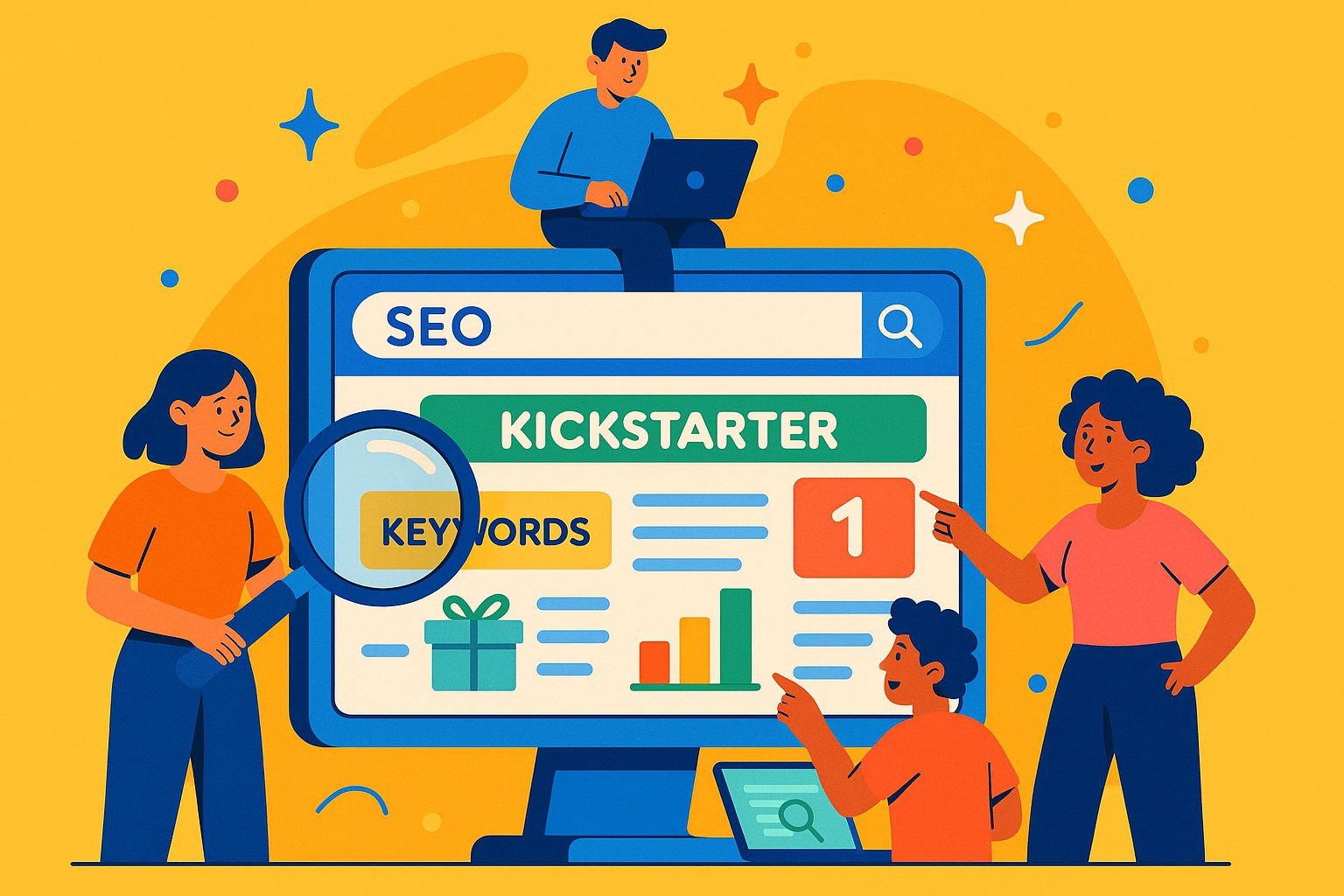Crafting a Magnetic Campaign Title and URL
Your Kickstarter campaign’s title is more than a tagline—it’s the first signal that search engines and potential backers use to judge relevance. Choose a title that weaves in your project’s core concept while still feeling succinct and memorable. Instead of simply “Smart Water Bottle,” consider “SmartHydrate: AI-Powered Water Bottle for Active Lifestyles.” This phrasing highlights both the innovation and the intended audience, improving search visibility when people hunt for “smart water bottle” or “AI water bottle.” Once you settle on your title, claim a concise URL slug that mirrors it—“/projects/YourName/smarthydrate-ai-water-bottle.” A straightforward, keyword-rich URL not only looks cleaner to visitors but also sends a clear signal to search engines about your page’s subject matter. Every time someone links to your campaign or shares it on social media, the chosen slug reinforces your core keyword phrase, making it easier for people to find you when they search for related terms.
Conducting Laser-Focused Keyword Research
Keyword research underpins every successful SEO strategy— and Kickstarter pages are no exception. Start by brainstorming phrases that potential backers might type when seeking a project like yours: “indie board game crowdfunding,” “eco-friendly tech Kickstarter,” or “artisanal jewelry campaign.” Plug these seed terms into free tools such as Google Keyword Planner or Ubersuggest to uncover related long-tail variations—phrases like “crowdfund board game with unique mechanics” or “sustainable tech gadget Kickstarter.” Aim for a balanced mix: high-volume terms like “Kickstarter board game” and more niche phrases that signal strong buyer intent, such as “preorder eco gadget Kickstarter.” As you compile your list, prioritize keywords that align closely with your project’s unique value proposition. These phrases provide the roadmap for sprinkling relevant terms throughout your campaign page—headlines, descriptions, reward titles, and updates—so search engines and curious backers alike recognize exactly what you offer.
Writing a Compelling Campaign Description with SEO in Mind
Your campaign description should leave readers excited about your vision, but it should also cater to search engine algorithms. Open with a strong, keyword-rich first paragraph—incorporate primary terms such as “reward-based crowdfunding” and “Kickstarter campaign.” For instance, “Our Kickstarter campaign for the EcoWell Smart Bottle reimagines how active individuals stay hydrated through AI-powered tracking.” This not only hooks readers but also tells search engines you’re talking about an “AI-powered water bottle” and “Kickstarter campaign.” Throughout the description, weave in secondary keywords—like “sustainable hydration solutions,” “early-bird rewards,” or “crowdfunded eco-innovations.” However, prioritize readability: let keywords flow naturally within your narrative. Use subheadings (H3 or bold text, though not required for SEO) to break up longer paragraphs, addressing features, use cases, and the team’s expertise—each subheading echoing relevant phrases. By striking the balance between persuasive storytelling and strategic keyword integration, you make it easier for both humans and bots to connect with your vision.
Optimizing Reward Tier Titles and Descriptions
Reward tiers aren’t just transactional — they’re opportunities to reinforce your campaign’s core message and boost discoverability. Rather than naming a tier “Early Bird Special,” consider “Early Bird: 20% Off EcoWell Smart Bottle.” This adjustment does two things: it clarifies the value proposition for backers and places “EcoWell Smart Bottle” directly into visible text. In each tier’s description, reiterate key features and include long-tail phrases—“AI hydration tracking,” “eco-friendly materials,” or “Kickstarter-exclusive price.” If one tier bundles accessories, label it “Eco Bundle: Smart Bottle + Solar Cap Attachment.” This additional keyword-rich text helps search engines understand the full scope of your offerings and surfaces your project for diverse queries. When backers skim through reward options, they appreciate clarity: they see precisely what they get and at what cost, while search bots index your page for nuanced searches like “solar cap hydration Kickstarter.”
Leveraging High-Impact Visual Assets and Alt Text
Compelling visuals—product prototypes, lifestyle photos, or behind-the-scenes shots—energize your campaign page, but they also present an SEO opportunity through alt text. Search engines can’t interpret images directly, so the descriptive alt attribute fills that gap. For a photo of your AI-powered water bottle in action, use alt text such as “EcoWell Smart Bottle AI hydration tracking rechargeable prototype.” By embedding descriptive phrases, you signal to search engines that the image relates to your core keywords. If you showcase the production process—say, injection molding or 3D printing—caption images with terms like “EcoWell smart bottle eco-friendly material injection molding.” Alt text not only boosts on-page SEO but also enhances accessibility for visually impaired backers. And when users share your images on social media or third-party blogs, properly labeled alt text often becomes part of the shared snippet, further strengthening your campaign’s visibility across the web.
Crafting a Click-Worthy Campaign Meta Title and Description
Though Kickstarter doesn’t allow direct editing of meta tags within their platform, you can still influence how search engines present your project via preview snippets. The first 100 characters of your campaign’s title and the beginning of your first descriptive paragraph often serve as the search engine’s default “title” and “meta description.” To seize control, ensure that your chosen campaign title appears exactly as you want it to display in search results—agency-style capitalization, key phrase positioning at the front, and concise wording. For the meta description approximation, craft a 150–160 character opening that summarizes your campaign’s core value: “Kickstarter’s EcoWell Smart Bottle uses AI to track hydration, made from recycled materials—early bird rewards start at $29.” This text, while not directly editable in Kickstarter’s backend, forms the basis for how search engines index and display your snippet. By maintaining a focused, engaging lead paragraph, you increase the likelihood that search engines will replicate your intended metadata, enticing users to click through to your campaign.
Encouraging Backer Engagement to Signal Relevance
Search engines interpret user engagement—clicks, shares, comments—as strong indicators that your content is valuable. Within Kickstarter, that means actively encouraging backers to leave comments, ask questions, and share updates on their social networks. Responding promptly to comments not only builds trust but also injects fresh, user-generated content into your page, showcasing keywords and phrases that backers naturally use. When backers post “Can’t wait for my EcoWell Smart Bottle!” or “I love the AI hydration tracking,” those comments reinforce relevant keywords without your direct input. Likewise, encourage backers to share your campaign on Twitter, Facebook, and LinkedIn. Each social share creates potential backlinks—signals that search engines use to gauge authority. The more authentic engagement your page generates, the more search algorithms categorize it as relevant and worthy of higher placement in results.
Building Strategic Backlinks to Your Campaign
High-quality backlinks — links from reputable websites pointing to your Kickstarter page — remain a cornerstone of SEO. Begin by reaching out to niche blogs, industry publications, and crowdfunding review sites with personalized pitches: “We’re launching EcoWell Smart Bottle on Kickstarter—a sustainable hydration solution with AI tracking. Would you consider featuring us?” If accepted, these publications typically include a direct link to your campaign, instantly boosting your page’s authority. Similarly, collaborate with relevant influencers who maintain blogs or niche websites—perhaps eco-lifestyle bloggers or tech gadget reviewers—offering them early access in exchange for an honest review. Leverage local community boards, university entrepreneurship centers, or industry forums, but avoid spammy tactics (e.g., mass directory submissions). Every time a respected source links to your campaign, search engines register a vote of confidence, helping your page climb the rankings for relevant keywords.
Structuring Updates for Continual SEO Benefits
Launching your Kickstarter campaign is not the finish line—it’s a dynamic process that unfolds over weeks. Periodic updates serve a dual purpose: they keep backers informed and signal to search engines that your page remains current. When you post an update about reaching a funding milestone or unveiling a new prototype feature, ensure you reintegrate primary keywords naturally. An update might read, “Milestone Achieved: 50% Funded for EcoWell Smart Bottle AI Water Tracker.” By beginning with a keyword-laden phrase, you reinforce the topic’s relevance each time an update publishes. Encourage backers to comment on these updates, generating fresh user content. When search crawlers revisit your page to check for new information, they identify these updates as signals of vitality, reinforcing your position in search results. Ultimately, consistent updates maintain momentum, boost engagement, and sustain your SEO efforts long after initial launch day.
Optimizing Campaign Videos for Search and Engagement
A high-quality campaign video can convert undecided visitors into enthusiastic backers, but you also want it to contribute to SEO. Host your video on a third-party platform like YouTube or Vimeo, embedding a properly optimized title, description, and tags before linking to it within your Kickstarter page. For instance, on YouTube, name the video “EcoWell Smart Bottle Kickstarter Campaign – AI Hydration Tracker” and include a brief description that highlights key features and directs viewers to your Kickstarter link. Within your campaign page, place the embedded video near the top and add a caption with essential keywords—“Watch our EcoWell Smart Bottle in action: AI hydration tracking, recycled materials, Kickstarter exclusive.” This approach accomplishes two things: it brings viewers directly to your Kickstarter page from YouTube searches and provides keyword-rich context for search engines to understand and index the embedded video content. Videos aren’t merely engagement tools—they’re SEO assets when optimized effectively.
Leveraging Social Proof and User Testimonials
Social proof works wonders for both SEO and conversion rates. When potential backers see genuine testimonials—photos of early prototypes in use, video snippets of satisfied users, or quotes from reputable industry figures—they trust your campaign more readily. Embed these testimonials in your campaign description, packaging them in paragraphs that incorporate relevant keywords. For example, a backer quote might read, “I started using the EcoWell Smart Bottle last week, and its AI tracking genuinely improved my hydration habits.” This natural integration reinforces “EcoWell Smart Bottle” and “AI tracking” while adding authenticity. Encourage backers to share their experiences via comments and social media, linking back to your campaign. Each shared post or tweet acts as an organic backlink, while the testimonial itself adds depth to your page’s content, signaling to search engines that your project meets real user needs.
Closing the Loop: Monitoring, Adjusting, and Sustaining SEO Efforts
SEO for your Kickstarter campaign doesn’t end once you publish—it thrives on continuous monitoring and adjustment. Use tools like Google Search Console and Ubersuggest to track which keywords drive impressions and clicks to your campaign page. Observe fluctuations in organic traffic and compare them against your promotional pushes, updates, or reward launches. If you notice certain keyword phrases lagging—perhaps “AI hydration Kickstarter” yields few results—consider tweaking your copy to include alternative terms like “AI water tracker crowdfunding” or “smart hydration Kickstarter.” Track backlink performance by reviewing referral traffic sources; if a particular blog post generated above-average backer clicks, reach out to similar outlets for expanded coverage. By treating SEO as an ongoing process rather than a one-time task, you ensure your campaign remains discoverable and continues to attract motivated backers throughout its entire lifecycle.
Final Reflections: From Visibility to Victory
Optimizing your Kickstarter campaign page for search engines is an essential strategy for transcending the inherent noise of crowdfunding platforms. By meticulously crafting a keyword-rich title, conducting thorough audience research, weaving targeted phrases into your descriptions, and encouraging genuine engagement, you construct a page that speaks directly to both search algorithms and human backers. Strategic backlinks, optimized multimedia, and consistent updates further reinforce your page’s authority, ensuring it ranks prominently for queries that matter. As your campaign progresses, a vigilant eye on analytics and a willingness to iterate keep your project nimble, responding to emerging trends and changing search behaviors. When search engines help guide curious innovators or passionate supporters to your page, you unlock a steady stream of qualified traffic, converting clicks into pledges. In the end, robust SEO transforms your crowdfunding vision into a discoverable reality—fueling the funding, enthusiasm, and community support that lead to ultimate success.




